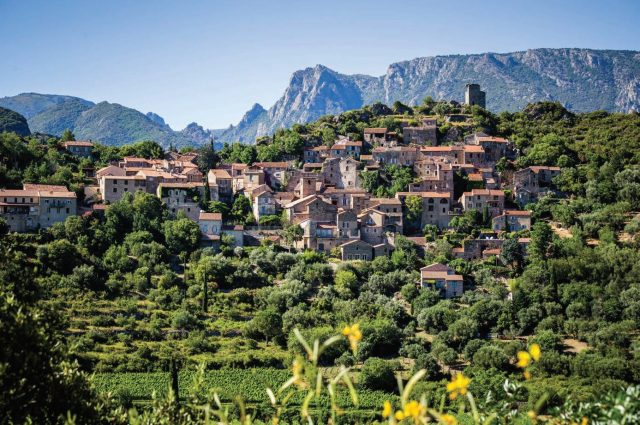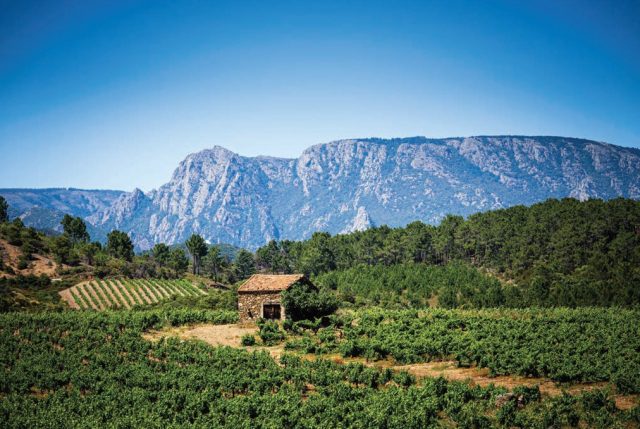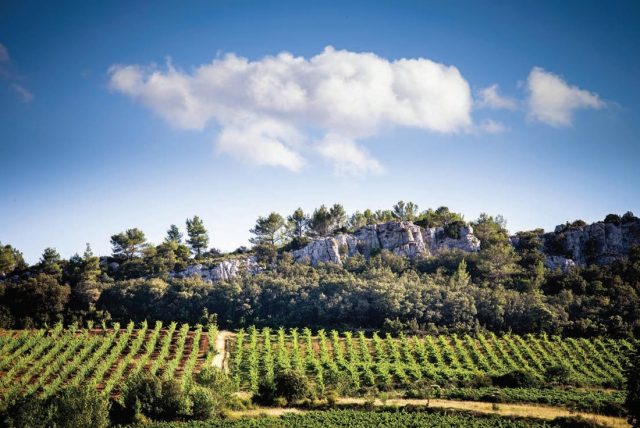This website uses cookies so that we can provide you with the best user experience possible. Cookie information is stored in your browser and performs functions such as recognising you when you return to our website and helping our team to understand which sections of the website you find most interesting and useful.
Why the wines of Saint-Chinian are ripe for a rediscovery
While hunting for expressions from little-known areas can be a joy, there is a region of Languedoc-Roussillon – Saint-Chinian – that is ripe for rediscovery, as our recent masterclasses proved. By Patrick Schmitt MW

WHEN SEARCHING for something different from the usual competitive vinous set, it’s important to remember that you don’t have to visit new frontiers of the wine world. There are brilliant alternatives to well-known wines within long-established areas.
Indeed, rather than researching the uncharted for obscure sources of wine, the novel may be right under our noses. It was with this thought in mind that we ran a pair of virtual masterclasses on the wines of Saint-Chinian – an area that represents a discovery for many new to wine, be they professionals or consumers, despite being within the world’s most famous wine-producing nation, France, and part of its most ancient and largest vineyard area: Languedoc-Roussillon.
Even for those who’ve been drinking and trading wine for several decades, Saint-Chinian is likely to be a ‘re-discovery’, because, while the wines from this part of southern France were once prominent on the shelves of UK wine sellers, in recent decades, their strong position in retailers and restaurants has been eroded as the number of Argentinean Malbecs and Rioja Reservas has increased. This means that today, for those who want to stand out from the crowd, and showcase something a little off the well-trodden wine path, Saint-Chinian is an ideal option.
Using a presentation and two sets of wines over a pair of events, we set out to encourage a trade audience to consider Saint-Chinian for a range of reasons, taking in its history, regional characteristics, and soils – factors that we’ve considered in more detail below.

HISTORY
With the vine entering France around the Mediterranean town of Narbonne in the fifth century, the Languedoc-Roussillon has the longest history of grape growing and winemaking in this country. An extensive vinous heritage is also evident in Saint-Chinian, with records of viticulture stretching back to the eighth century, when the Benedictines were cultivating grapes in the area – the region and its village take their name from a canonised monk, St Anian. Notably, the grapes of those times are similar to the varieties used in the region today: Carignan, Mouvèdre, Grenache and Syrah. So, after centuries in the same soils, such varieties are well-adapted to the region.
Moving forward to modern times, in 1982 Saint-Chinian red and rosé wines gained appellation status. They were followed in 2004 by white wines and the two village-designated appellations Saint-Chinian-Berlou and Saint-Chinian-Roquebrun, as vignerons realised that low-yielding hillside vineyards were best suited to quality wine production.
In total, Saint-Chinian comprises 3,100 hectares of vineyards spread over 20 villages, producing around 100,000hl per year from 90 independent producers and eight co-operative wineries (see boxout). It’s just a tiny part of the 240,000ha farmed in the Languedoc-Roussillon wine region, which produces the equivalent of 817 million bottles.
THE REGION
Saint-Chinian sits at the foot of the southern slopes of the Massif Central, facing the Mediterranean. The region is bordered to the north by scrubland, and to the south by the Béziers wine plain, while it’s placed between the larger appellations of Faugères and Minervois. It’s a rugged, dry and windy wine-producing area, backed by the beautiful peaks of the Cévennes, and interspersed with native shrubs such as lavender, sage, rosemary, and thyme, collectively known as garrigue. The climate is typically Mediterranean with mild winters, hot, dry summers and little rainfall. Saint-Chinian is located in one of the windiest regions of Languedoc, with a north wind from the foothills of the Massif Central bringing a night-time cooling in the summer, which is beneficial for slowing down the ripening of the grapes.

SOILS
Importantly, Saint-Chinian is divided in two according to soil type, with the north of the region composed of shale/schist, as found in Faugères, to which it is attached.
In the south, surrounding the village of Saint Chinian, the vineyards lie on a clayey-limestone which, it’s said, produces less full-bodied wines. According to Jancis Robinson MW: “Those vines grown on schist produce sharper wines… those grown lower down on purple clay/limestone around village of Saint-Chinian itself are softer.”
Previous tastings of wines from Saint-Chinian have shown that the products from schist-based soils tend to be a touch darker in appearance, with more dried fruits, minerality, intensity and tannin than those from the clay-limestone sites, which tend to be lighter, softer, fruitier, and showing a clearer varietal expression. Winemaking decisions will have a marked impact on style, but the tasting considered whether such conclusions were borne out in the wines tried, with the attendees given information on the soil types as the samples were tried.
Before the wines were tasted, other grape-growing areas with schist were considered. Prominent among these are Alsace, Beaujolais, parts of the Loire valley, and the northern Rhône, along with the Douro valley and Faugères.
Another area, and one made famous by its schist, is Priorat, in northeast Spain. Similar to Saint-Chinian, Priorat grows Carignan and Grenache in a dry Mediterranean climate. The major difference between these two regions comes with notoriety, with Priorat far 54better known as a source of fine reds. This suggests that Saint-Chinian presents a particularly good-value alternative, and an area of untapped potential that may become famous for its combination of schist, Mediterranean grapes and climate in the future.
After two masterclasses, featuring a total of 16 wines, it did appear that the reds from schist-based vineyards had more tannin, a prune-like taste, with spice and a crushed rock character, and those from the clay and limestone soils a touch more softness, and more obvious varietal flavours, be they the blackberry and olive of Syrah to the strawberry and pepper of Grenache. But, there was no clear division in quality, with top-scoring wines evident from both types of bedrock.
Overall, Saint Chinian proved to be an area deserving of greater attention from the trade, due to its extensive history, ideal grape-growing conditions, distinctive and diverse soils, and wines with personality and quality, at an accessible price. In other words, Saint-Chinian is the source of affordable, interesting, authentic drops, and they come from a beautiful part of the world. In short, it’s a highly credible alternative to the usual suspects that’s ripe for a discovery, or, for those who remember its heyday in the UK trade, a rediscovery.
Masterclass 1
DOMAINE DE SAINT-CELS, COMBE LONGUE, 2020
Producer: Domaine de Saint-Cels
Grape variety: Grenache Blanc, Roussanne, Vermentino
ABV: 13.5%
Closure: Cork
Soil type: Limestone-clay
Approx. retail price: £10
DOMAINE CANET VALETTE, UNE ET MILLE NUITS, 2019
Producer: Domaine Canet Valette
Grape variety: 40% Grenache, 30% Syrah, 20% Mourvèdre, 10% Carignan
ABV: 14.5%
Closure: Cork
Soil type: Clay and limestone soil
Notes: Organic – certified (Ecocert)
Approx. retail price: NA
DOMAINE LA CROIX SAINTE EULALIE, CUVE�E BAPTISTE, 2019
Producer: Domaine la Croix Sainte-Eulalie
Grape variety: 55% Syrah, 18% Carignan, 15% Grenache Noir, 12% Mourvèdre
ABV: 14%
Closure: Cork
Soil type: Schists and sandstone
Approx. retail price: £12
MARIE DE LAUZERDA, SECOND PAS SUR LA LUNE, 2018
Producer: Domaine Marie de Lauzerda
Grape variety: 60% Grenache, 40% Syrah
ABV: 14%
Closure: Cork
Soil type: Clay and limestone
Approx. retail price: £10
DOMAINE PECH DE LUNE, EQUINOXE, 2017
Producer: Domaine Pech de Lune
Grape variety: 40% Syrah, 30% Grenache, 30% Carignan
ABV: 14%
Closure: Cork
Soil type: Clay and limestone
Approx. retail price: £10
Notes: Organic –– certified
DOMAINE DES MATHURINS, TANGO POUR HÉLÈNE, 2020
Producer: Domaine des Mathurins
Grape variety: 60% Grenache, 40% Syrah
ABV: 13.5%
Closure: Cork
Soil type: Limestone clay
Notes: Organic
Approx. retail price: £8
DOMAINE LA LINQUIÈRE, LE CHANT DES CIGALES, 2018
Producer: Domaine La Linquière
Grape variety: 70% Syrah, 15% Mourvèdre, 15% Carignan
ABV: 14.5%
Closure: Cork
Soil type: Schists, clay and limestone and sandstone
Ageing: 12 months in oak barrels
Approx. retail price: £10
Masterclass 2
DOMAINE DU SACRÉ COEUR, CHARLOTTE, 2019
Producer: Domaine du Sacré Coeur
Grape variety: 90% Very old Carignan (up to 120 years old), 5% Syrah, 5% Grenache
ABV: 13%
Closure: Cork
Soil type: Clay and limestone
Ageing: on fine yeasts for 18 month. 80% in tanks and 20% in new French oak barrel.
Approx. retail price: £14
LA CAVE DE ROQUEBRUN, R PREMIUM, 2019
Producer: La Cave de Roquebrun
Grape variety: 55% Syrah, 25% Grenache, 20% Mourvèdre,
ABV: 13.5%
Closure: Cork
Soil type: Schist
Approx. retail price: £10
DOMAINE LA LAUZETA, CORTEZA, 2019
Producer: Domaine La Lauzeta
Grape variety: 40% Grenache, 34% Syrah, 14% Carignan, 12% Cinsault
ABV: 14.5%
Closure: Cork
Soil type: Schist
Approx. retail price: £20
CLOS BAGATELLE, AU FIL DE SOI, 2018
Producer: Clos Bagatelle
Grape variety: 37% Mourvèdre, 37% Grenache, 26% Syrah
ABV: 14%
Closure: Cork
Soil type: Limestone
Ageing: 12 months in barrels (20 % new oak)
Approx. retail price: £20
DOMAINE DES JOUGLA, AIMADIS, 2018
Producer: Domaine des Jougla
Grape variety: 50% Syrah, 50% Mourvèdre
ABV: 14%
Closure: Cork
Soil type: Schist, clay and limestone
Notes: Organic, hand-picked and de-stemmed,
LES VIGNOBLES FONCALIEU, VIA NOSTRUM, 2018
Producer: Les Vignobles Foncalieu: 7,000ha/1,000 growers
Grape variety: 85% Syrah, 15% Grenache
ABV: 14%
Closure: Cork
Soil type: Limestone.
Approx. retail price: £12
CHÂTEAU LA DOURNIE, ETIENNE, 2017
Producer: Château la Dournie
Grape variety: 60% Syrah, 25% Grenache Noir, 15% Carignan
ABV: 14%
Closure: Cork
Soil type: Schistous soils
Ageing: 12 months in oak barrels and 12 months in vat.
Approx. retail price: £15
CAVE DE SAINT-CHINIAN, 8 SECRETS, 2017
Producer: Cave de Saint-Chinian
Grape variety: 50% Grenache, 30% Mourvèdre, 20% Syrah
ABV: 14%
Closure: Cork
Soil type: Clay-limestone
Ageing: 18 months in barrel.
Approx. retail price: £20
Saint-Chinian: a snapshot
- The Benedictines cultivated vines in St-Chinian in the eighth century, and the village takes its name from a canonised monk, St Anian.
- 1982 is the year when Saint-Chinian red and rosé wines gained appellation status. They were followed in 2004 by white wines and the two village-designated appellations Saint-Chinian-Berlou and Saint-Chinian-Roquebrun.
- 3,100 hectares are declared as Saint-Chinian across 20 villages, producing 100,000hl/year.
- Saint-Chinian comprises: 90 independent wineries, eight co-operative wineries
- The region produces 80% red wines, 15% rosés and 5% whites
- The sales are split: 75% domestic, 25% export
- The authorised grape varieties are: Red: Grenache, Syrah and/or Mourvèdre (minimum 70%), Carignan, Cinsault (maximum 30%) White: Grenache Blanc (minimum 30%), Marsanne, Roussanne, Vermentino (Rolle). Additionally, Clairette, Viognier, Bourboulenc, Macabeo, Carignan Blanc are permitted to a maximum of 10%.
- The maximum yield is 45hl/ha
- The soil of Saint Chinian is divided into two distinct parts: in the north, it is composed of shale/schist and in the south, the vineyards lie on a clayey limestone.


